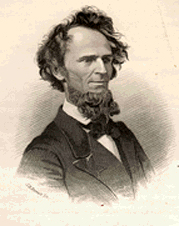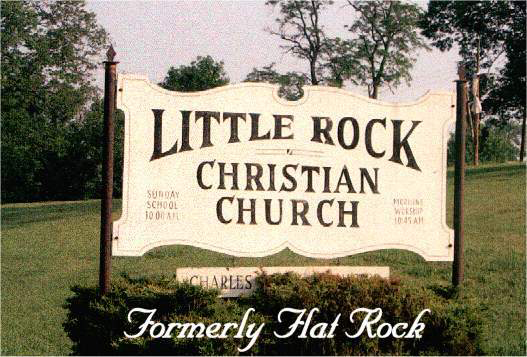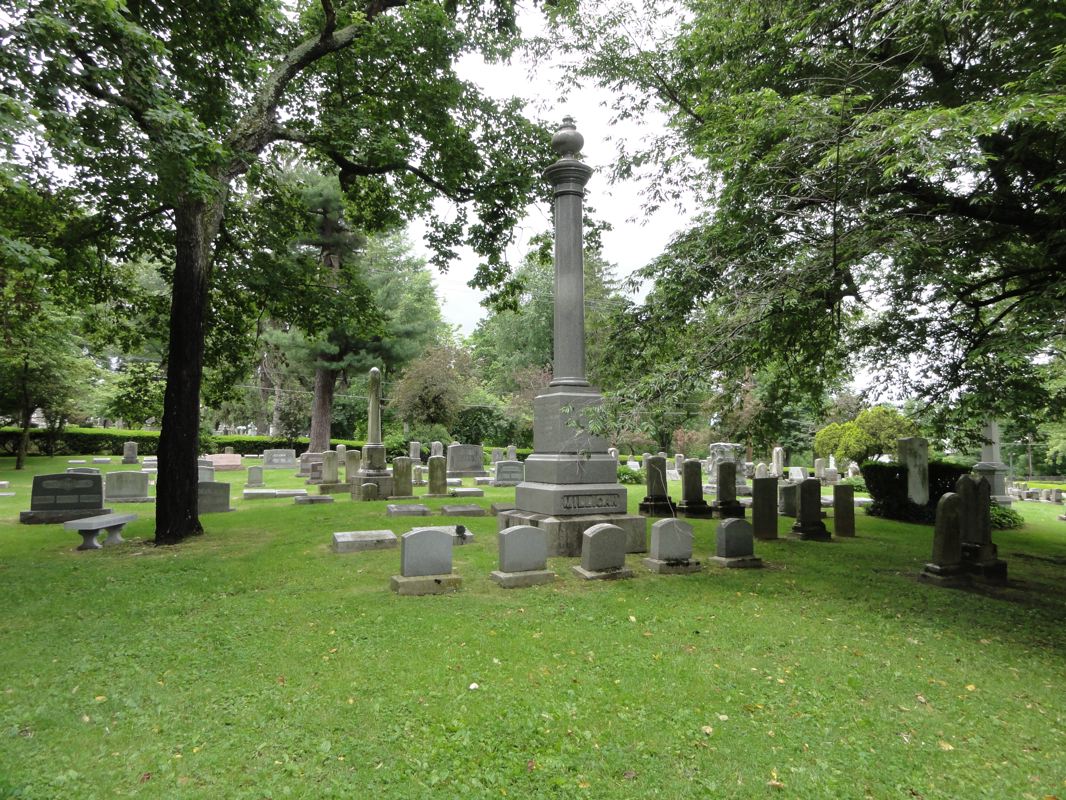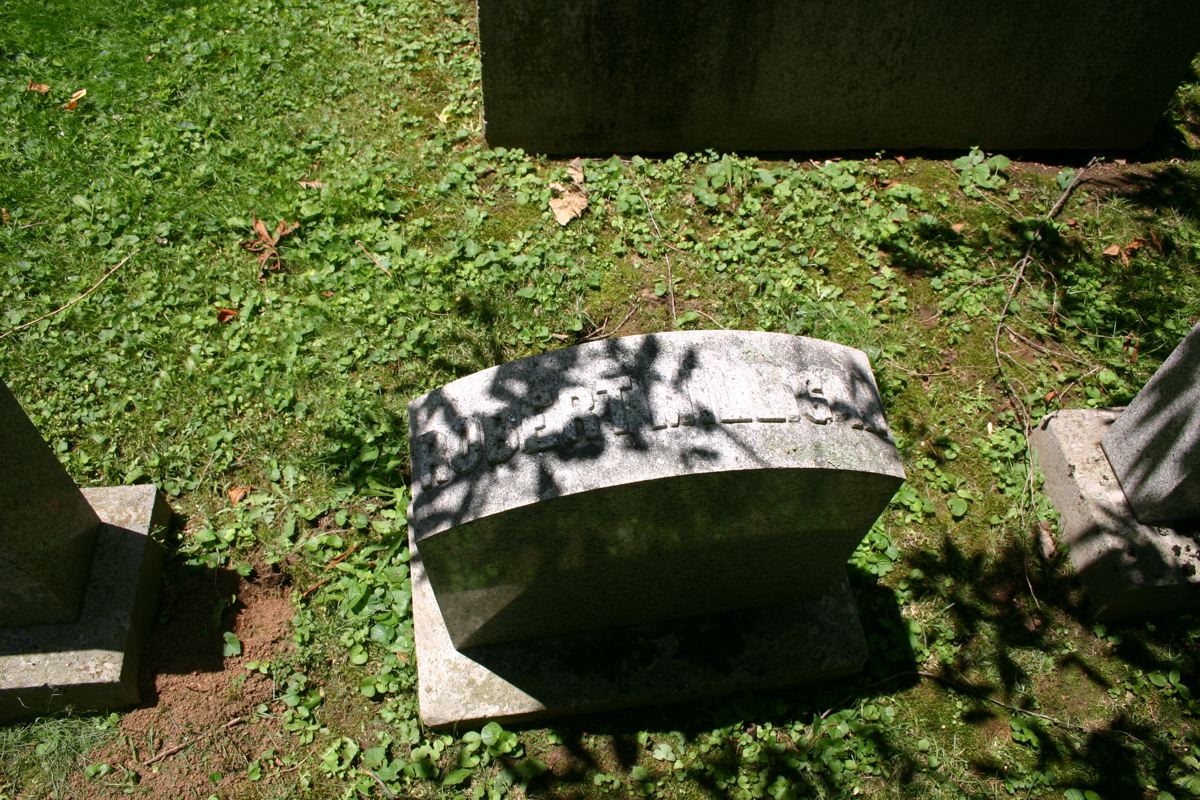1814-1875

![]()
Sketch By Brown
Sketch By Rogers
Sketch By McGarvey
GPS Location Of Milligan Grave
Grave Pictures
Biographical Sketch On The Life Of Robert Milligan
The life of Robert Milligan is a book of lessons triumphing over disheartening hindrances, of doing thoroughly well whatever one undertakes to do, of self-denying consideration of what is due to others, and of entire consecration of one's self and one's all to the service of God.
He was born in Tyrone, a county of the most northern province of Ireland, July 25, 1814. In 1818 he was brought to the United States by his parents, John and Margaret Milligan, who settled in Trumbull county, Ohio, which was afterward the native county of the late President McKinley. An injury to his chest, which he received while helping to clear a field of his father's farm, and the mark of which he bore till his death, turned his thoughts toward a professional life. In 1831 he entered Zelienople Academy, in Beaver county, Pa., and, in 1833, a classical academy, conducted by a graduate of the University of Edinburgh at Jamestown in the same State.

As one of nine children of parents in moderate circumstances, he had to begin life for himself before he had completed his collegiate training. Accordingly, in 1837, he opened a school at Flat Rock, in Bourbon county, Ky., with fifteen pupils. Three months afterward he was refusing to receive more than fifty, the number which he thought that he could not exceed in justice to those already received. When he was twenty-one years of age, he had become a member of the home congregation of the Associate Presbyterian Church, in which his father was a ruling elder. A careful study that he made, during his stay at Flat Rock, of the New Testament in the original Greek, resulted in his immersion on March 11, 1838, by Elder John Irvin, of the Church of Christ at Cane Ridge.
Earnestly desiring the advantages of a collegiate education, he left Kentucky in 1839, with the intention of entering Yale College. His journey over the National Road brought him to Washington, Pa. A delay, occasioned probably by his unwillingness to travel on the Lord's Day, led to his remaining in Washington, where he could attend what was then called Washington College, and where he could at the same time worship with the small congregation of disciples in the neighboring village of Martinsburg. Graduated in 1840 with the degree of Bachelor of Arts, which had then a very definite meaning, he was at once promoted from the tutorship which he had held in the college before his graduation, to the professorship of the English language and literature. In this chair, which he filled for nearly ten years, he cultivated a careful acquaintance with the masterpieces of English literature, and during a part of that time he gave instruction in Greek and Latin classics also. Meanwhile, in 1842, he married Miss Ellen Blaine Russell, of Washington, whose father at the time, and one of whose brothers afterwards, represented the Bedford (Pa.) district in Congress. Though she was but a few months younger than her husband, she still enjoys a cheerful old age, living with her only son and daughter in Lexington, Ky. In 1843, Professor Milligan received from his alma mater the degree of master of arts, and in 1849 or 1850 he was transferred to the department of chemistry and natural history. When in 1852 the College was placed under the control of the Presbyterian Synod of Wheeling, he insisted on the acceptance of his resignation, that the institution might be wholly in the hands of those who were entitled to guide its fortunes.
Invited at once to Bloomington, Ind., he had first the chair of mathematics, and then that of chemistry, natural philosophy and astronomy, in Indiana University. The degree of doctor of divinity, which was tendered to him by the University, but he declined. Resigning his professorship at Bloomington, because of the ill health of his son, he accepted in 1854 the chair of mathematics and astronomy in Bethany College, in what was then a part of Virginia. Besides the duties of his professorship, he discharged those of an elder of the church at Bethany, and for three years, beginning with 1857, he was a co-editor of the Millennial Harbinger.
In May of 1857, he was elected president of Bacon College at Harrodsburg, Ky. The name of the institution having in the meantime been changed, he was inaugurated president of Kentucky University on Wednesday, Sept. 21, 1859, which was the third day of the first session under the new name. After the destruction of the college building by fire, in February of 1864, had made the removal of the institution from Harrodsburg necessary, he was a member of the committee that decided in favor of removal to Lexington. When Kentucky University, which had now attained university proportions, was reorganized in 1865, with its founder as the head of the associated colleges, President Milligan was placed at the head of the College of the Bible, a place most congenial to his tastes and purposes, which he filled until his last illness.
Few educators have had as laborious a preparation for their noble calling as had Robert Milligan. In the interval between the beginning of his life as a teacher in colleges in 1840, and his death thirty-five years afterward, he taught, and that efficiently and acceptably, in four institutions of learning and in all the departments of the curriculum of liberal studies, as that curriculum then was, except that of modern foreign languages. To his assiduous work in colleges and universities he added the labor of preaching often, sometimes regularly, for churches in or near the towns of his residence. He had been ordained in 1844 a minister of the gospel, with imposition of the hands of Elder Thos. Campbell, the venerable father of Alexander Campbell. He addressed educational meetings of different kinds, he lectured in other institutions of learning, he wrote much for religious periodicals. The community, the college, the university, in which he lived and labored always felt that there was present a quiet but active influence which could be counted on in whatever concerned morality or religion. To the Tract on Prayer, which he had written before, he added in the last ten years of his life the volumes entitled Reason and Revelation, The Scheme of Redemption, The Great Commission, Analysis of the Gospels and Acts, and, which was published as a posthumous work, Commentary on Hebrews. And all this was in great physical weakness, the result of the impairment of his constitution first by the accident already mentioned as having befallen him in his youth, and afterward by diseases, none of which ever left him after it had attacked him, and the mere mention of which is sufficient to excite wonder how suffering so much he could do so much, and how doing so much he could suffer so long. His purpose of taking a rest before the last scene should release him from weakness and from suffering was thwarted by an erysipelas which, attacking a body now almost defenseless against disease, left him too feeble to recover. He died peacefully, in full possession of his faculties, and surrounded in his home by his family and by friends, on March 20, 1875. His death was lamented in the communities in which he had lived and was deplored throughout the Christian brotherhood. The Apostolic Times concluded its announcement of his decease with "A prince is this day fallen in Israel;" the American Christian Review declared that he was one of those "of whom the world was not worthy;" and President John W. McGarvey, his friend and co-laborer in the College of the Bible, in the funeral discourse which he pronounced, summed up the general estimate of his character in the words that are repeated on his monument in the Lexington cemetery: "He was a good man, and full of the Holy Spirit and of faith."
- From Churches Of Christ, ed. John T. Brown, 1904, pages 418-420,
Note: This is a timed piece. All who were described as being alive at the time of its writing are now deceased.
back to table of contents
ROBERT MILLIGAN (1814-1875)
George Rogers
The success and duration of any institution is largely due to its leadership. The College of the Bible (known since 1965 as Lexington Theological Seminary) was no different. Who was this Robert Milligan? His life was so outstanding that a college chartered in 1881 bore his name-six years after his death. Milligan College continues to honor his name.
Even though he was a scholar, teacher, preacher, and voluminous author, he possessed not vanity enough to leave behind even a sketch of his useful life. What we learn is largely from the pen of Professor J. W. McGarvey, his close friend and associate. A brief study reveals a life that suffered much and patiently endured physical pain without embitterment. In spite of much suffering, he lead a busy and eventful career. His friends summed up his life as a good man whose heart overflowed with the love of God. An eminent scholar and teacher, he was a master in the classroom in the arts of literature and science. His most important contribution is found in his books with his fame based primarily in five major works: Reason and Revelation (1868), An Exposition and Defense of the Scheme of Redemption (1868), The Great Commission of Jesus Christ lo the Twelve Apostles (1871), Analysis of the New Testament (1874), and Commentary on Hebrews (1876).
A BIOGRAPHICAL SKETCH
Robert Milligan was born in the county of Tyrone, in north Ireland, July 25, 1814. At age four his parents came to America. They settled on a farm in Trumbull County, Ohio. While helping his father clear new ground, young Milligan received a chest injury which caused him to give up farming and perhaps changed the course of his life.
In 1831, being seventeen years of age, he entered a classical academy in Beaver County Pennsylvania taught by Dr. John Gamble. Two years later he enrolled in a classical academy at Jamestown, Pennsylvania. He seems to have made rapid progress. At age twenty-one he was back at his father's house. As his parents were devoted members of the Reformed Presbyterian Church, he was at this time fast becoming a communicant in that religious group.
Looking for a milder climate farther south, at age twenty-three, he opened a school of classical arts at Flat Rock, Bourbon County Kentucky (now Little Rock). He also taught the Scriptures to his students. Questions from his students caused him to rethink his faith, "he was thus providentially made to realize the great responsibility of the man who presumes to interpret for others the oracles of God." 1
Thus with an open mind studying the Bible in the originals, he concluded that he was a member of a church not authorized in the word of God. So, on March 11, 1838, he was immersed by Elder John Irvin of the Cane Ridge congregation three miles away.
After two years at Flat Rock he determined to resume his education at Yale. On his way to New Jersey, he stopped at Washington, Pennsylvania, to visit friends. A small group of disciples persuaded him to stay and teach them. He stayed, and entered Washington College receiving his B.A. degree at the age of twenty-six. Shortly after graduation, he was offered a professorship at Washington College. He was also set apart as a preacher of the gospel among these Christians according to the custom of the time. Thomas Campbell laid his hands on Milligan. While at Washington, he studied the classics in both Greek and Latin languages. When the college was brought under control of the Presbyterian Synod, thus more strictly denominational, Milligan resigned. However, during this time he met and married Ellen Blaine Russell in January 1842, the twenty-eighth year of his life, and she was said to have remained his faithful wife until his death.2
In 1852 he accepted an offer to teach mathematics at the University of Indiana in Bloomington. He also taught chemistry, astronomy, and natural philosophy. The University would have bestowed upon him the doctor's degree, but he refused. Because of ill health and that of his family, he resigned after two years. Alexander Campbell's Bethany College had been seeking his services as a professor for some time, so he accepted this offer and moved to Bethany, West Virginia.
At Bethany College, he taught mathematics and astronomy. He was ordained an elder in the Bethany church of Christ, and was appointed coeditor of the Millennial Harbinger. Professor J.W. McGarvey writes that for five years he was, . . . discharging the duties of his professorship with his accustomed assiduity, and entering upon a work of personal religious labor among the students of the college and the citizens of the community such as had never before been known in that institution.3
Thus his influence was distinctly felt by the young men in the college, and by numerous others in the community.
During these years Bacon College at Harrodsburg, Kentucky, had closed its doors because of financial problems. Mr. John Bowman, an alumnus, was able to raise $200,000 to aid in reopening the school. It was rechartered as Kentucky University. Thus the school began to attract attention from the entire disciples' brotherhood. When John Bowman and his advisors began to search for a new president they fixed their eyes on Robert Milligan. It was a hard decision to leave a field where he had been so successful. In a letter to McGarvey in June, 1857, he wrote, "Nothing but a sense of duty will induce me to dissolve my present relations; but I confess that it is difficult to withstand the generous appeals of my Kentucky brethren."4 In 1859, he answered this call to return to Kentucky and assume the presidency of Kentucky University. The school opened with one hundred ninety-four students. The faculty consisted of Robert Milligan as president, Robert Richardson, Henry H. White, John H. Nieville, and Robert Graham. Kentucky University remained in Harrodsburg until the summer of 1865, when most of the buildings were destroyed by fire. A committee was formed to raise another $100,000. They were successful; a new location was found, and "the University was removed to Lexington, Kentucky, where it succeeded to the property of Transylvania University.”5 After moving to Lexington during that year, Robert Milligan resigned as president of Kentucky University and became head or president of the College of the Bible. It was one of three colleges of the University. Robert Milligan and John W. McGarvey were the faculty. Milligan held this position until his death. As an administrator, his success was blunted somewhat by his indecision, but his life's real purpose was realized and fulfilled in his classroom work and his writings. He taught for a period of thirty-five years as a college professor and was very successful. Having great intellectual power, he was master of every situation with his students, sometimes appearing as a king on his throne. He was a man of humility and peace. When financial difficulties developed and the question arose over the misuse of money to the College of the Bible, Professor J. W. McGarvey was asked to resign. Milligan was opposed to the dismissal of McGarvey and appeared before the Board of Curators on McGarvey's behalf. He said,
. . . allow me to say that it has never been my good fortune to cooperate with any man more earnest in his work, and in the course of thirty-three years as a teacher I have never met one more honest and faithful in the discharge of his duties than Professor McGarvey.6
The President's appeal was in vain and McGarvey was dismissed; however, records show that he was later reinstated. Milligan was able to stay on as he would go to great pains to avoid conflict. He pursued peace, was devoted to his work, and seemed to labor long with less regard to personal interests. During his last days at the College, he was ill much of the time. He insisted on meeting his classes, even though he was ordered by his doctor to stay in bed. When unable to attend the classroom his students would meet at his home for instruction.
He wrote a total of seven religious volumes and almost all of them during the time of his college duties and with failing health. During his last days he had to take medicine each day. His physician told him to drink some whiskey or brandy each day, but he refused because of the dreaded influence it might have on others, especially his young students.
Many think that Milligan's Scheme of Redemption was his greatest work. It was used, it seems, in ministerial training during those early days and is still used in reprinted editions in the classrooms of some Christian colleges. The book deals with the nature of God, the beginnings, the patriarchal age, the giving of the law at Sinai, and then proceeds to discuss the person and work of Jesus Christ. After discussing the Holy Spirit and conversions, he proceeds to discuss the church, its organization, work and ultimate glorification.
Robert Milligan died March 20, 1875, at the age of sixty-one. J. W. McGarvey had the privilege of sitting by his side during the last hour or two of his life. His funeral was held at the Broadway Christian Church in Lexington. The building was crowded with family and friends and many could not gain admittance. The service was conducted by McGarvey and Graham. At the grave Professors Ricketts and McGarvey led prayers. It is very evident that he was held in high esteem by his associates. We quote from the Apostolic Times:
"Robert Milligan will long live in the affectionate remembrance of thousands. He was of the few who seem to be elevated above the race by the purity and blamelessness of their lives. Not a few think he was the best man they ever knew. To those whom he educated for the Christian ministry he was inexpressibly dear. In him were united the humility, simplicity, and candor of a child with the loftiest traits of a noble manhood. Though dead he will live in the labors he has left as a precious legacy to the world and the church. One such life is worth more than a volume of arguments for the truth of our holy religion. He was a shining example of the rich grace of our God; and to Him we give all the praise for such an example of piety as we have in our departed friend and brother."7
Standing some twenty to thirty feet high in the beautiful Lexington Cemetery is a marble monument erected by family and friends to his memory. Carved into the stone are these words: "Robert Milligan, Born in the country of Tyrone Ireland, July 25, 1814, Died in Lexington, Kentucky, March 20, 1875. —He was a good man and full of the Holy Spirit and of faith."
CONCLUSION
The life of Robert Milligan (1814-1875) represents a man, a man who became an early student, teacher, preacher, author, scholar, and administrator. He taught a classical school at an early age. He became a New Testament Christian at age twenty-four or perhaps twenty-five, thus entering the Restoration Movement at Cane Ridge, Bourbon County Kentucky.
His influence was widely felt in the brotherhood through his teachings and writings. His aim was always to bring about a clearer understanding of the Scriptures. He saw the Bible as a whole and his views were formed after intensive study of Scripture. His writings reveal that he taught much on fundamental and doctrinal subjects such as conversion, the Holy Spirit, the Judgment, baptism for the remission of sins, instrumental music and church worship. Some of his thoughts on prophecy and his position on the millennium question would differ from most of us holding the Restoration Plea today, but this would not reduce his major impact as a meticulous and prolific writer.
His love for God and his word seemed to be the dominating factor in his life. He was a liberal giver to the poor, and especially to his poor students. His pain and sufferings, especially in the later days, did not prevent his living an humble, obedient, and useful life. We are sometimes amazed at his success. Will we do as well?
1 'Henry Leo Boles. Biographical Sketches of Gospel Preachers. (Nashville. Gospel Advocate. 1932). p. 171.
2 "President Robert Milligan" (editorial) The Apostolic Times VII (April 1, 1875). p. 126-127.
3 “President Robert Milligan." Op. cit.. p. 126.
4 'Robert Milligan. The New Testament Commentary (St. Louis, Christian Publishing Co. 1875). p. 391.
5 Catalogue Of Kentucky University (Lexington. Transylvania Printing Company, 1893). p. 4.
6 Ibid., p.21
7 "Death or President Milligan" (editorial) The Apostolic Times (March 25, 1875), p. 128.
-FHU Lectures, 1981,
George Rogers, pages 288-292
back to table
of contents
Directions To Grave:
Lexington Cemetery is one of the most beautiful old cemeteries in America. It is located on West Main Street heading away from downtown Lexington toward Leestown Pike. Turn right into the main entrance past the office. Once inside the gates take the second turn to the left that leads up to the front of the Clay Monument. Then turn left onto West Main Avenue. Follow the road on around past Sections "D,H,O &P" Just past "P" on your right look back to your left and see the grave of Robert Milligan & I.B. Grubbs is just a little further down on the left.
GPS Location
38.058554,-84.511774
20 Ft. Accuracy
Grave Faces North
Section T, Lot 40, Part S
![]()


